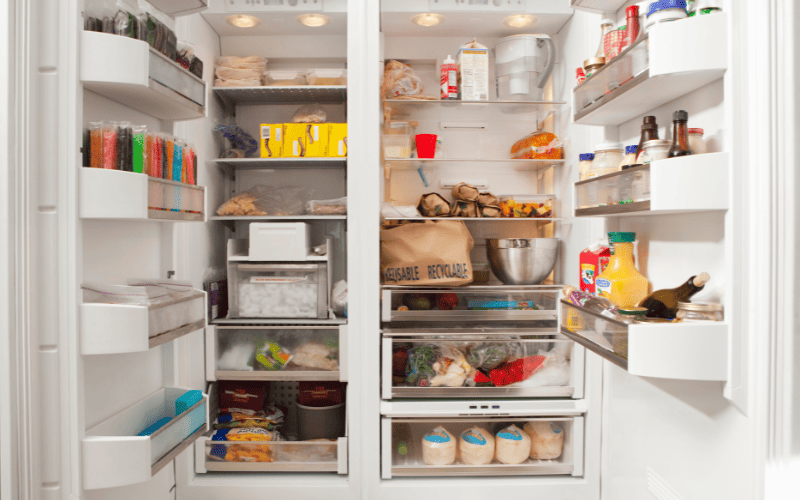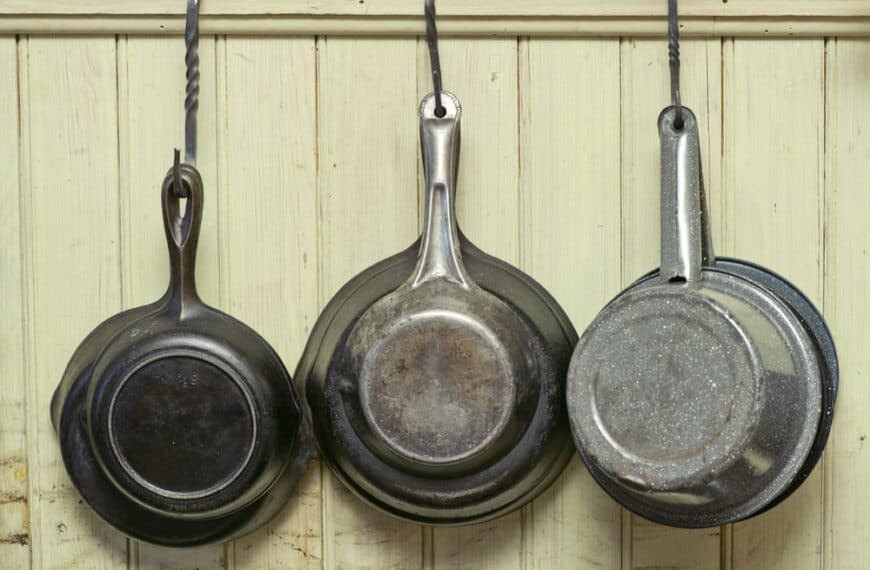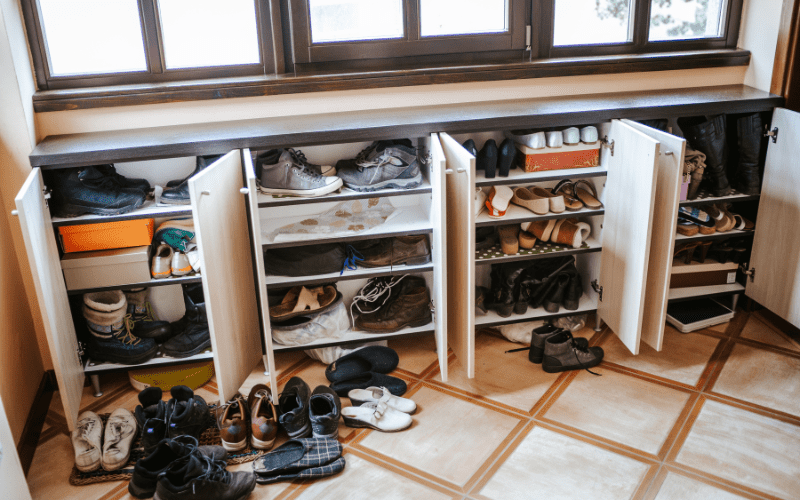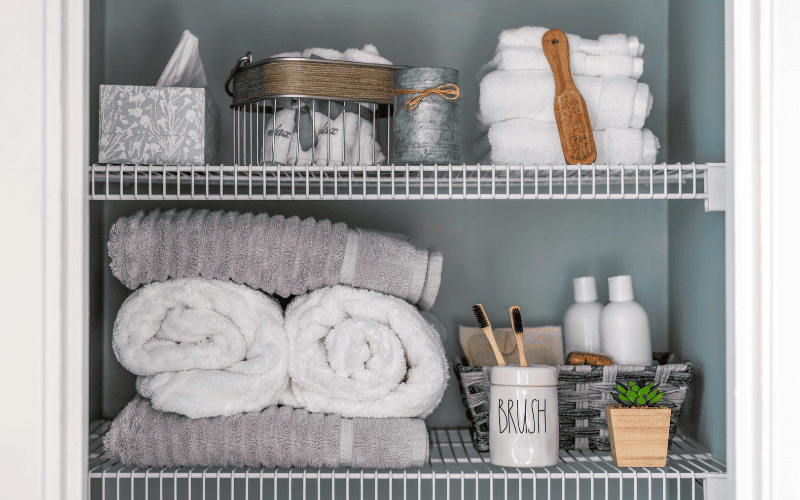The simple rules to organizing any fridge are about designating zones, grouping similar items, and adding helpful storage containers.
Sorting your fridge correctly makes produce last longer, reduces waste, and minimizes your chances of buying duplicates, which helps you save money. An organized fridge also frees up extra room, makes things easy to find, and makes food appear more appetizing.
Use the following fridge organization ideas to achieve an aesthetically pleasing, efficient fridge interior.
How to Organize Your Refrigerator
Designating specific locations for items based on zones, grouping like foods, and adding handy storage tools, allows you to organize your fridge quickly.
1. Group Similar Items and Put Them in Functional Spots
The best way to organize your fridge is to give your home’s staple food items a functional, designated spot and group similar items together.
Check out this video:
The top shelf and refrigerator door are the warmest, and it becomes progressively cooler as you go down. This is not only because heat rises but also because of the continual opening and closing of the door. Drawers also tend to be temperature regulated thanks to their enclosed format.
To make the best use of your fridge’s space and help food last longer, situate items as follows:
- Dairy products, spreads, and eggs on the upper and middle shelves
- Milk and meats on the bottom shelf where it is coldest
- Condiments in the fridge door
- Fruits and veggies in the crisper drawers
Eggs are best kept in their original carton as it prevents them from absorbing other flavors and odors from your fridge.
In addition to the zones, grouping items together or in the same area makes them easier to locate and grab, saving you time. It also makes it harder to displace or forget you have certain ingredients.
Create a go-to area for snacks, small items, and drinks. Breaking your condiments into smaller groups, like dressings, BBQ sauces, and burger toppings, can also help you maintain tidiness.
You can store canned drinks, water bottles, juice boxes, and other drinks in the door or on one shelf, but it may make more sense to keep them by your milk where it is cold.
2. Adjust Refrigerator Shelves as Needed
Before moving forward, ensure your shelves are in a position that helps you maximize vertical space.
Assess how you normally use the interior and adjust the levels as needed. For most homes, having both tall and narrow shelves is the best layout.
Pro Tip: This is the perfect time to clean the inside of your fridge and eliminate odors. Sticking a box of baking soda inside can also help.
3. Remove Bulky Packaging
Another way to maximize and save space in your fridge is to remove bulky, unnecessary packaging. This means eliminating plastic bags, cardboard boxes on soda or sparkling water cans, and any other unnecessary exterior wrappings.
For items like cheese or half-eaten produce that require a cover, beeswax wrap is an eco-friendly option.
4. Add Storage Bins and Liners
Use bins to sort and contain particular foods by category and expand drawer space. Storage bins are a complete game changer when organizing your fridge. They help you maximize space, reinforce zones, and keep everything in place.
When choosing your storage containers, consider their size, shape, versatility, price, and type to ensure they serve your needs. Think about what you want them to hold and how much space you have for them inside your fridge.
Types of fridge bins:
- Open top
- Stackable bins with lids
- Produce savers
- Narrow/slim fridge bins
- Glass storage containers
- Lazy susans
A clear fridge bin with handles and an open top is often the best type for organizing. They are easy to pull out, allow you to view the contents, and make items easy to grab. You can store snacks, cans, and anything else in these open drawers.
Stackable bins with lids keep produce or dairy fresh and maximize vertical storage. This is because stacking bins function like an additional crisper drawer.
A lazy susan or turntable is great for condiments and small, slender containers.
Pro Tip: Labeled bins ensure everything stays in place. Adding labels to a container also makes it easier to find items.
Placing liners on bottom shelves catches leakage from meat. Using shelf liners under bottled wine, cans, and other drinks on a narrow shelf also helps keep them in place.
5. Separate Fruits and Veggies
Store vegetables and fruits separately. Most fruit emits ethylene gas that causes vegetables to ripen faster, leading to quicker decomposition.
When you keep fruit in a separate drawer or covered bin, it contains the gas. As a result, your veggies stay fresh for longer, and your fridge stays more organized.
6. Put Perishable Items in Clear View
Always place perishable foods like leftovers, produce, and other items with shorter expiration dates in the front of your fridge. Most people forget about things in the back because they can’t see them easily.
A direct view of perishable food makes you more likely to eat them before they go bad, minimizing food waste. Ensuring easy access also enhances appeal for kids.
Mason jars are perfect for smaller items like fresh herbs. Wide-mouth mason jars are also great for leftovers.
Are Fridge Bins Worth It?
Using a bin or bins in your fridge is the best way to get organized. They create clear dividers, allow you to use every inch of storage space within your fridge, and function as extra drawers.
You can always organize your fridge without bins using the other tips above, but your hard work may come undone faster.
Fridge bins are easily found at a container store or online. They also work in the freezer if you want to do your full fridge.
How Does Marie Kondo Organize Her Refrigerator?
Marie Kondo is a professional organizer known for her decluttering techniques. Her top tip for organizing your fridge is to keep it approximately 30% empty. Don’t overstock and leave extra space for leftovers and additional groceries.
Maintaining an Organized Fridge for Better Use
Organizing your fridge helps you eat everything before it goes bad, optimizes space, and makes food more accessible. Utilizing cold zones, grouping foods together, keeping perishables in front, and adding bins is a surefire way to achieve fridge organization. When you’re done, you can move on to the pantry, freezer, or kitchen drawers.













